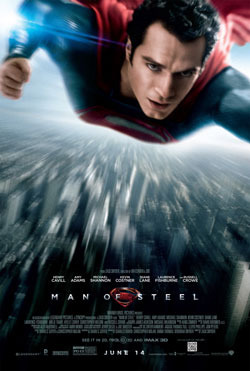Forging Man of Steel
 I like Superman—as a character, as a superhero, as an embodiment of (certain) values. I looked forward to seeing Man of Steel this summer. Although I was disappointed, I’ll start with its strengths. Warning: Spoilers ahead.
I like Superman—as a character, as a superhero, as an embodiment of (certain) values. I looked forward to seeing Man of Steel this summer. Although I was disappointed, I’ll start with its strengths. Warning: Spoilers ahead.
The importance of point-of-view in defining “good” versus “evil” is nicely portrayed. According to my typology of supervillains classification scheme, this incarnation of Zod is a heroic villain. His actions are motivated by—what is to him—an altruistic cause (saving Krypton/Kryptonians). This is made explicit at the beginning of the film, when Zod says to Jor-El (Superman’s father) that he’s taken up the sword against his own people for a greater good. Jor-El, too, could be considered a heroic villain in that he’s done something against Kryptonian law, but is doing so for what he believes is a greater good. It’s not a “black and white” morality tale.
The film (accurately) portrayed the social challenge of being gifted (i.e., “super”). Like many superheroes, gifted children sometimes hide their talents and abilities from others for fear of social ostracism or harassment. In Clark Kent’s case, though, it was because the government might want to “take” him. The young Clark views his budding powers as burdens to be hidden, yet Clark’s father explains that one day he’ll view his abilities as gifts, not burdens.
Amy Adams’ Lois Lane is the best screen version thus far. She’s smart and spunky but not high strung or temperamental. It’s easy to see why Clark would like her (which isn’t true in the other films). She’s an admirable character. Way to go!
The aspects of the film that I didn’t like were, unfortunately, numerous. One fundamental flaw rests on the reason for Jor-El and Lara trying to conceive “naturally” on Krypton: To bring a child into the world that wasn’t pre-conceived or pre-programmed with a destiny. (On this version of Krypton, it seems that children’s DNA is genetically engineered to fill society’s niches—soldier, scientist, etc.—and fetuses are externally incubated.) Yet the young adult Clark discovers a holographic-type projection of his long-dead father, who tells Clark what his destiny is—why he was sent to Earth. He’s “supposed to guide humans, to be a force for good. You will help them to accomplish wonders.” This hypocritical stance about destiny versus free choice is a major plot flaw.
Another plot contradiction is the alien-among-us fear, which drives much of story of Clark’s childhood, but is carelessly thrown off by the end of the film. After downtown Metropolis has been practically laid waste by aliens, no humans seem worried about Superman being an alien, or even that there was an alien battle on Earth.
Finally, the wanton destruction, the endless fight scenes, explosions, buildings collapsing became boring. I couldn’t help but notice that the Daily Planet building took its share of damage, yet by the end of the film, the Planet’s office looks fine. There no sense of the trauma that Metropolis’s citizens experienced since their city was a center ring in which aliens fought. The city is magically clean and rebuilt by the end. We have to suspend disbelief in most superhero films (perhaps Christopher Nolan’s Batman films being the exception), but not this much.
The film was called Man of Steel, but too little of the film was actually about Superman. It was really about Jor-El versus Zod, with Superman acting as proxy for Jor-El. I wanted to see more character development about the adult Clark/Superman. In a film over two hours long, it seemed that his screen time—when he wasn’t in a fight scene—was too brief and his “character development” superficial.
This film contrasts dramatically with the Nolan Batman films, which is ironic because the script was written by the same folks who wrote Batman Begins: Jonathan Nolan and David Goyer. Whereas Batman Begins provides wonderful and psychologically insightful character development, Man of Steel does not.
Robin S. Rosenberg, PhD, ABPP is a clinical psychologist in private practice in San Francisco and Menlo Park, Calif. She often writes about the psychology of superheroes. Her latest books are What Is a Superhero? and Our Superheroes, Ourselves.
Subscribe to the OUPblog via email or RSS.
Subscribe to only television and film articles on the OUPblog via email or RSS.
Image credit: Man of Steel movie poster TM & © 2013 WARNER BROS. ENTERTAINMENT INC. ALL RIGHTS RESERVED. TM & © DC COMICS (From DC Entertainment), via manofsteel.warnerbros.com, used for the purposes of illustration.
The post Forging Man of Steel appeared first on OUPblog.









 Related StoriesA love of superheroesSuperhero essay competition: tell us your favorite superpowerQuickcast – COMIC CON
Related StoriesA love of superheroesSuperhero essay competition: tell us your favorite superpowerQuickcast – COMIC CON
Oxford University Press's Blog
- Oxford University Press's profile
- 238 followers



